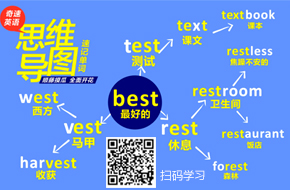同义替换题是近几年中考英语的常考题型,其出题形式通常是同时给出两个句子,第一句完整,第二句中设空,要求填入适当的词或短语,使第二句的意思与第一句意思相同。同义替换题综合考查学生的词汇、语法等知识,要求运用所学的词汇、语法知识完成句子,使句子结构完整、逻辑合理、语法知识无误、意思与所给句子相同。
通过对近几年该题型的分析,我们发现中考英语同义替换题主要考查以下几个方面:
1
运用同义词(组)
用同义词或同义短语对原句中的某些词或短语进行替换,注意转换后的词或短语的词形变化要与句子其他成分相适应。如:
1. That day we could see flowers here and there.
That day we could see flowers __________.
答案:everywhere
解析:everywhere与here and there都表示“到处”。
2. The teacher always takes good care of the children in the school.
The teacher always ______ ______ the children well in the school.
答案:looks after
解析:take good care of与look after…well都表示“好好照顾”。
奇速英语国际精英特训营:中外名师+32小时奇速征服初中三年单词+听、说、读、写
招生对象:初一、初二、初三、优秀小学生及同等英语水平的社会人士
初中英语特训营培训内容:
1、32小时速记初中1600高频词汇
2、专利思维导图巧记英语单词
3、直击中考重点难点奇速突破
4、资深外教全面提升口语能力
5、全面提升阅读完形写作能力
6、增强联想思维开拓国际视野
奇速英语国际精英特训营:中外名师+48小时奇速征服高中三年单词+听、说、读、写
招生对象:高一、高二、高三、优秀初中生及同等英语水平的社会人士
高中英语特训营培训内容:
1、48小时速记高中 3500 词汇
2、24个故事引人入胜环环相扣
3、聚焦高考重点难点奇速涨分
4、风趣外教剖析英美寓教于乐
5、语法阅读完形写作综合提升
6、足不出川尽享纯正西式教学
奇速英语国际精英特训营更多详情建议登录奇速英语官网进行了解http://www.qisuen.cn/course/?uid=jyj ,或者直接咨询奇速英语蒲老师电话(微信):18780237521 QQ: 2421469696。
2
反义词(组)的否定式
即用反义词或短语的否定式表达与原句相同的意思,主要考查学生对反义词(短语)的积累和换位思维的能力。如:
1. It’s clear that this visit is different from last time.
It’s clear that this visit is not the ______ ______ last time.
答案:same as
解析: be different from意为“与……不同”;the same as意为“与……相同”,其否定式与be different from同义。
2. I think wealth is less important than health.
I ______ think wealth is ______ important than health.
答案: don’t ; more
另外,有的反义词不用与否定词连用,只需改变句子结构也可构成同义句。如:
He lent some money to his friend.
His friend ______ some money ______ him.
答案:borrowed; from
解析:borrow …from …意为“向……借……”;lend…to... 意为“把……借给……”。
3
运用不同语态
即运用主动语态与被动语态的变化来转换同义词, 但此时要特别注意时态一致性。如:
1. Everyone should give back his library books on time.
Library books should______ ______ ______ on time.
答案:be given back
解析:被动句中含有情态动词should,因此助动词用be。
2. It is widely accepted that more people use computers in the world today.
It is widely accepted that computers ______ widely ______ in the world today.
答案:are;used
解析:computers是复数名词,助动词用are。
4
非延续性动词与延续性动词
非延续性动词与延续性动词进行转换,此时往往会涉及时态的变化。如:
1. The manager left two hours ago.
The manager ______ ______ ______ for two hours.
答案: has been away
解析:leave为非延续性动词,不能与for two hours连用,而be away则可连用一段时间。
2. The film began five minutes ago.
The film has been _____ _____ five minutes.
答案:on for
解析: has been提示时态是现在完成时态,“for + 时间段”表示“持续(一段时间)”,常用在含有现在完成时态的句子里。
3. Mr Li joined the Party twenty years ago.
Mr Li _____ _____ _____ the Party for twenty years.
答案:has been in
5
直接引语与间接引语
此时要注意相关时态、人称、动词、状语等相应的变化。如:
1.“I’ve found my wallet,” he said to me.
He ______ me that he______ ______his wallet.
答案:told;had found
2. “Did you see her last week?” he said.
He ______ ______ I had seen her the week ______.
答案:asked if / whether; before
6
简单句与复合句
即将简单句变成同义的复合句或将复合句变成同义的简单句。如:
1. We didn’t go out for a walk because it was raining.
We didn’t go out for a walk ______ ______ the rain.
答案:because of
2. He was so excited that he couldn’t go to sleep.
He was ______ ______ ______ go to sleep.
答案:too excited to
解析:将so…that…换成too…to…结构,原句的that从句为结果状语从句,改写句中的不定式仍表结果。
3. Now I will show you how to do the work.
Now I will show you ______ ______ ______ do the work.
答案:how you can
解析:即将原句中的“疑问词+不定式”结构转换成宾语从句。
4. You should put them back after you use them.
You should put them back _____ _____ them.
答案:after using
解析:即将after引导的状语从句改写为after引导的介词短语。
7
并列句与复合句
即将并列句变成同义的复合句或将复合句变成同义的并列句。如:
1. Come on, or we’ll miss the early bus.
______ we ______ hurry, we’ll miss the early bus.
答案:If;don’t
2. The man gave us a talk last week. He will give us another talk this week.
The man ______ gave us a talk last week ______ ______ us another talk this week.
答案:who / that;will give
解析:who/ that gave us a talk last week为定语从句,修饰先行词man。
8
运用关联词连接或合并句子
即运用关联词both…and…,neither…nor…,either…or…,not only…but also…等将两个简单句合并为一个简单句。此时要注意的是,both…and…连接两个主语时,谓语总是用复数,而neither…nor…,either…or…,not only…but also…连接两个主语时,谓语动词通常应与靠近的主语保持一致。如:
1. Tom can’t speak Japanese well and Jim can’t, either.
______ Tom ______ Jim can speak Japanese well.
答案:Neither;nor
解析:neither…nor…表示“……和……(两者)都不”,刚好与原句的两个否定结构的意思相吻合。
2. Alice has read the book and Peter has read it, too.
______ Alice ______ Peter have read the book.
答案:Both;and
解析:both…and…的意思是“……和……(两者)都”。
3. This store sells men’s shoes, and it also sells men’s clothes.
This store sells ______ ______ men’s shoes ______ ______ men’s clothes.
答案:not only;but also
解析:not only…but also…表示“不仅……而且……”之意。
9
某些经典句式或结构
这类典型结构如so…that…,too…to…,enough to,not…until…,so do I 等。如:
1. Jim wants to go boating and his parents want to go boating, too.
Jim wants to go boating, and ______ ______ his parents.
答案:so do
2. John went to bed after he finished his homework.
John ______ go to bed ______ he finished his homework.
答案:didn’t; until
解析:not…until意为“直到……才”。





